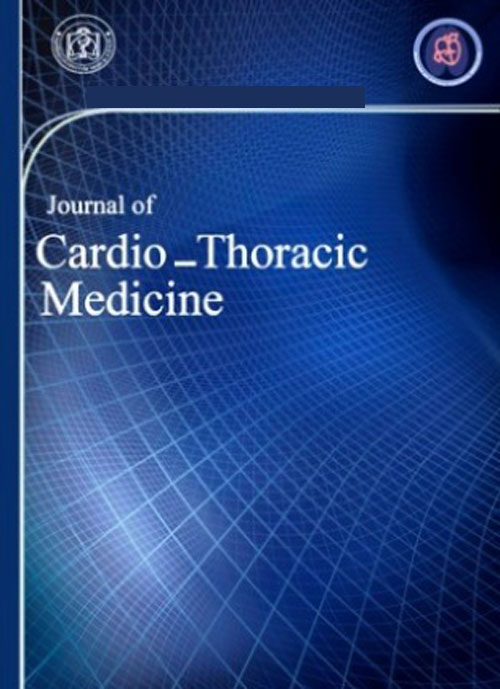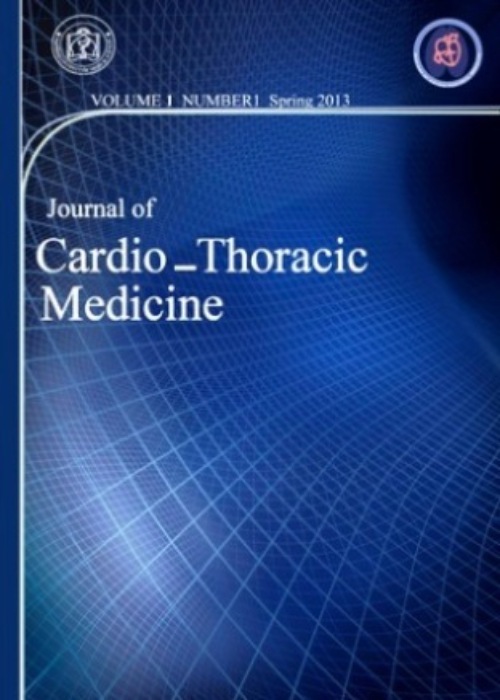فهرست مطالب

Journal of Cardio -Thoracic Medicine
Volume:8 Issue: 3, Summer 2020
- تاریخ انتشار: 1399/06/26
- تعداد عناوین: 8
-
-
Pages 645-650IntroductionCoronary artery bypass grafting is a surgical operation that bypasses atherosclerotic coronary vessels and restores blood flow to the ischemic zone of hearts. And two different conventional methods are ON-pump CABG, and Off-pump CABG. Altogether, the efficacy and safety of these two types of surgical procedures are still under debate. In this study, we aim to compare the efficacy, safety, and cost-effectiveness of these two different methods in admitted patients to Imam Reza Hospital in Mashhad in Iran during 2006 to 2016.Materials and MethodIn this prospective cohort study, 533 patients who underwent CABG in Imam Reza hospital in Mashhad during 2006 to 2016 were identified. The data was collected using hospital records including demographic data, chief complaint, history of previous disease, ejection fraction, number of graft, blood transfusion, time of anesthesia, time of surgery, days of hospitalization, days of ICU stay, needs for reoperation, post-operative complication, expenses of hospitalization.ResultsOf 533 patients were 347 patients of whom male. The mean age was 59.53±10.21 and the mean BMI was 26.38±5.4. The most common chief complaint of the patients was chest pain. 38 patients of 533 cases underwent on-pump surgery and 495 underwent off-pump technique. There were no significant differences for age, and gender. The prevalence of HTN, diabetes, MI, and hyperlipidemia had no differences among two groups. Renal failure was more common in on-pump group; whereas, pulmonary disease was more common in off-pump group. On-pump surgery required significantly longer hospitalization and ICU care. Also needs for reoperation was more common among on-pump surgery. Total expenses were significantly higher in on-pump group.10.5% of those who underwent on-pump surgery died after surgery. This rate was only 3.1% among off-pump group.ConclusionIn this study we showed that, the patients who underwent on-pump surgery, required longer hospitalization, and ICU care. Total expenses were significantly higher in on-pump group. In addition, the mortality rate of on-pump group was significantly higher than the off-pump group. Also needs for reoperation was more common among on-pump surgery. Altogether, it seems that off-pump surgery is safer with low expenses than on-pump CABG.Keywords: Coronary Artery Bypass, Grafting Cardiopulmonary Bypass, Off- Pump Mortality Rate
-
Pages 651-656IntroductionAcute pulmonary embolism (PE) is one of the deadly cardiovascular diseases. One of the indexes proposed in these patients for risk stratification is the Thrombolysis in Myocardial Infarction (TIMI) risk index (TRI), which includes three parameters of systolic blood pressure, age, and heart rate. This study aimed to evaluate the predictive value of TRI on in-hospital and 30-day mortality of PE patients.Materials and MethodsThis cross-sectional study included 345 patients who were diagnosed with acute PE in Madani Heart Center from January 2012 to January 2017. Demographic characteristics, hemodynamic findings upon first admission, type of treatment (i.e., thrombolytic, anticoagulant, or surgery), as well as in-hospital and 30-day outcomes were recorded for all patients. The TRI and simplified Pulmonary Embolism Severity Index (PESI) were calculated for all patients.ResultsThe overall and in-hospital mortality rates were 8.7% and 8.1%, respectively. The mortality group were significantly older and had significantly higher heart rates, cardiac troponin levels, simplified PESI scores, and TRI followed by lower systolic blood pressure and O2 saturation. Moreover, the TRI obtained specificity, sensitivity, positive, and negative predictive values of 98.78%, 25.25%, 89.29%, and 76.66%, respectively, using receiver operating characteristic curves and a cut-off value of 36.73. Using the multiple logistic regression analysis we found that TRI>36.73, older age, higher heart rate and lower SBP could predict 30-day mortality.ConclusionTheresults showed that the risk of in-hospital mortality is higher with an increase in TRI. Furthermore, despite the high specificity, lower sensitivity limits its utility.Keywords: Pulmonary Embolism, Mortality, Thrombolysis
-
Pages 657-661IntroductionThe enlightenment of Hydro-pneumothorax arrived in former times of primitive Greece. It is a term which explains simultaneous existence of both free air and fluid (i.e., pneumothorax and hydrothorax) in the pleural space.The goal was to contribute and update the knowledge of clinical aspect as well as yield of diagnostic modalities in handling the cases of Hydropneumothorax.Materials and MethodsDiagnosed cases of hydropneumothorax from casualty and routine OPD are considered. Detail of clinical background entered. Patients were subjected for analysis of sputum, blood and pleural fluid. Radiological investigation was done. Patients underwent tube thoracotomy procedure and observed till resolution.ResultsTotal 97 subjects had participated. Among them 76(78.35%) were men and 21 (21.64%) women. 91(93.85%) subjects had shortness of breath. 34 subjects (35.05%) had tuberculosis in the past. Sputum smear AFB was positive in 19 subjects (19.58%). Plural fluid GeneXpert MTB was detected in 11 subjects (11.34 %) and MGIT Culture positive in 23(23.71%) subjects. Plural fluid gram stain culture was conclusive in 24 (24.74%) subjects. Pleural fluid ADA was raised in 74 (76.28%) subjects. Hypoxemia was observed in 46 (47.42%). In 38 (39.19%) cases chest tube was removed between 31 to 60 days.ConclusionTuberculosis turns up as the most common aetiology of hydropneumothorax and duration required for resolution is uncertain. Evaluation of pleural fluid (cytology, microbiological culture, biochemical measure) and Computed tomography were essential to reach aetiology of condition. Chest tube thoracotomy remains most practiced modality of treatment in hydropneumothorax. However advanced techniques have promising outcome and it’s an opportunity to research further.Keywords: Hydropneumothorax, Tuberculosis, tube thoracotomy, plural fluid, Intercostal drainage tube
-
Pages 662-665Although classic and standard procedure for patients with ascending Aorta aneurysm with Sever aortic Regurgitation is Bentall surgery but in some selected cases this complex surgery was not performed with different reason like advanced age and coexisting comorbidity involving renal and hepatic and lung Function. In our cases 75 years old man with chronic renal failure ( Cr= 3.2 ) who was known case of sever aortic Regurgitation and Ascending Aortic Aneurysm with 5.5 diameter.replacement of Aortic Valve with Biologic Prosthesis Aortic Valve and Reduction Aortoplasty with Mesh prosthesis was done successfully with good result with early follow up.Keywords: Aortic Aneurysm, Aortic Surgery, Aortic Valve
-
Pages 666-669Mediastinal epidermoid cyst is a rare condition that is considered as a congenital disorder. Various manifestations from asymptomatic cases to serious symptoms may be found in these patients. However, some cases may be diagnosed incidentally. Here, we report an old man with recurrent pneumonia who demonstrated symptoms of respiratory distress and chest pain. The high resolution computed tomography (HRCT) and subsequent magnetic resonance imaging (MRI) showed a hypodense mass with internal calcification. CT-scan guided transthoracic needle biopsy confirmed diagnosis of mediastinal epidermoid cyst. The mass was resected through open surgery and patient’s symptoms were subsided.Keywords: Epidermoid cyst, mediastinum, Pneumonia
-
Pages 670-674Thymic epithelial neoplasms are commonly aetiology of the anterior mediastinum masses in adults. It represents 20–30% of all mediastinal tumours in adults. Ectopic thymomas usually affect the neck, mediastinal compartments, lung, and pleura, arising from aberrant thymic tissue. For giant thymoma, there is still no consensus on the surgical approach. We herein report a patient with a giant thymoma that was successfully resected through a large right posterolateral thoracotomy. We report a rare case of a giant thymoma in the posterior mediastinal. Our patient underwent a conventional posterolateral thoracotomy to remove the mass. This latter was histologically diagnosed as a WHO classification type AB thymoma and Masaoka stage I. The choice of surgical approach of mediastinal tumor is based on the tumour topography, the assessment of tumour extension and extirpation, the surgeon's experience and clinical symptomatology. A multidisciplinary approach is mandatory to achieve good results.Keywords: mediastinal tumour, posterolateral thoracotomy, thymic epithelial neoplasms, Thymectomy, Thymoma
-
Pages 675-678Our report discusses a patient diagnosed with PAN since 3 years ago. He presented with fever, chills and nonproductive cough. He was a long time receiver of immunosuppressant drugs for his underlying condition. Upon examination he was febrile, had cushingoid appearance and cackles in both lungs. Lung CT scan showed opacities in right upper lobe lung and multiple bilateral nodules and ground glass opacity along with mild thickening of pleura. A bronchoscopy was ordered to asses PCP, and without hesitation empirical therapy was started. However, his clinical condition did not improve as expected. At this time, suspecting another infection at play, a PCR and BAL specimen was ordered for CMV. After receiving the result of BAL analysis, our suspicion was confirmed for both PCP and CMV pneumonia. CMV is an important opportunistic infection in immunocompromised individuals. This case highlights this importance in immunocompromising conditions. In this setting, presence of respiratory signs and symptoms point out to PCP as the first differential diagnosis; but at the same time it’s crucial for clinicians to consider the possibility of CMV as a co-infective agent.Keywords: Co-infectious Cytomegalovirus, Pneumocystis Jiroveci, Pneumonia, Polyarteritis Nodosa Patient
-
Pages 679-683Sofosbuvir is an antiviral drug that entirely revolutionized the treatment of hepatitis C. This drug has an Iranian commercial brand, which is known as Ledibiox. Several adverse events have been reported with this drug, including syncope, pancolitis, and exacerbated pulmonary arterial hypertension; however, arrhythmia rarely has been described through the literature. Here, we report a 40-year-old Caucasian man who presented with chest pain, tachycardia, blurred vision, and severe headache; whose electrocardiography showed an atrial tachycardia along with a block. It seems that Sofosbuvir toxicity can cause arrhythmia, and the drug prescription should be halted in this situation.Keywords: Arrhythmia, Cardiac, ledipasvir, sofosbuvir, Ledibiox


